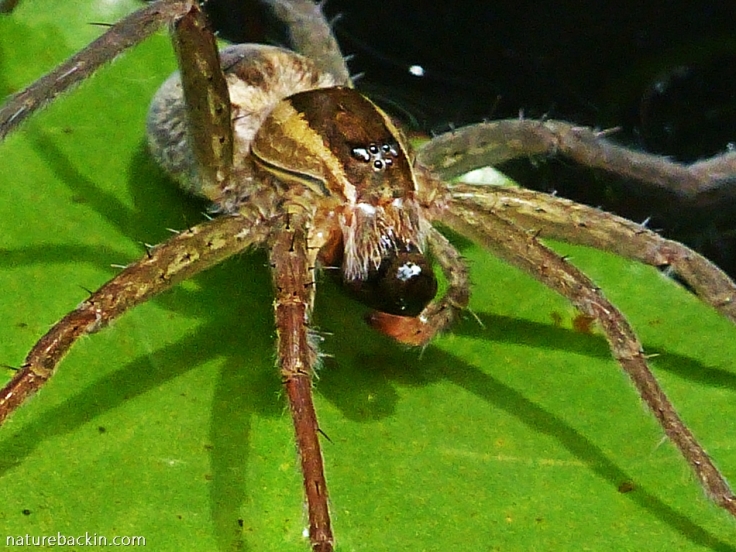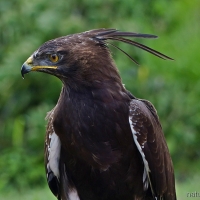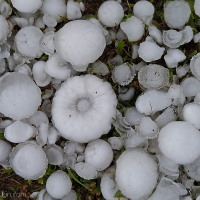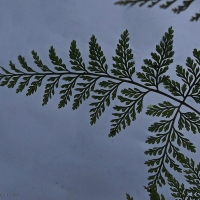I often see fishing spiders in our garden pond, but this is the only time I have seen one actually catching prey, and I was fortunate to have the camera with me.
Fishing spiders, also known as raft spiders, occur across the world, and the African species are in the genus Nilus (formerly Thalassius). Fishing spiders are able to move across the surface of the water without breaking the surface tension, but when waiting for prey they usually anchor themselves using one or more legs to an object that floats or sticks out of the water.

A fishing spider in our garden pond with its hind legs on a lily leaf and its other legs spread on the surface of the water. From here it can catch insects or tadpoles that pass nearby
Fishing spiders spend a lot of time motionless as they wait for prey to approach. If threatened or disturbed, they can submerge by climbing down objects protruding from the water and they can remain underwater for up to 35 minutes.

The spiders in our pond vary quite a bit in colour. I guess there is colour variation within a single species rather than that they are different species present in the pond. In the photo above the spider has its hind legs on a rock and its front legs on the surface of the water. In the bottom left corner of the photo, the shed exoskeleton of a spider can be seen floating in the water

For much of the year there are many tadpoles in the pond. Here they can be seen feeding on algae on the surface of a submerged rock

In the photo above, several tadpoles are feeding on the surface of a lily leaf. They eat algae on the surface of the leaf but I have also seen them eating the lily leaves too

I suddenly became aware that a spider on the lily leaves was eating a tadpole

The spider’s venomous bite (harmless to humans) immobilises the prey and also liquefies the insides of the prey so that it can be sucked into the spider’s stomach and digested

As the spider was already busy eating a tadpole I was not too worried about a tadpole that was moving around under the forelegs of the spider on the lily leaf

It turned out that I should have been worried. Though still eating, the spider suddenly turned and grabbed the tadpole that had been swimming under its forelegs

The spider uses its pedipalps to hold the prey while eating. The spider’s eyes, which are in two rows, can be seen in this photo

Fishing spiders can catch prey that is large relative to the size of the spider, and in addition to catching tadpoles and insects, some species of fishing spiders may also catch little fish and even small frogs such as reed frogs.
I like to regard the garden pond as a peaceful space, but of course that is an illusion.
Source: Pisauridae – an overview. ScienceDirect Topics. https://www.sciencedirect.com/topics/agricultural-and-biological-sciences/pisauridae
P.S. This post is scheduled to publish while I am away on holiday mostly with no Internet connectivity. I will catch up next week when I am back.
Posted by Carol









February 19, 2019 at 6:14 pm
Wow!! Your photos of fishing spiders are magnificent. Thanks for sharing.
LikeLiked by 1 person
February 20, 2019 at 7:05 pm
Thanks so much for your very kind comment. Its a pleasure to share the small but often interesting discoveries I come across in my backyard.
LikeLiked by 1 person
February 15, 2019 at 4:49 am
Loved reading this!
LikeLiked by 1 person
February 15, 2019 at 5:48 am
Thank you and for letting me know ☺
LikeLike
February 3, 2019 at 5:20 am
What a great set of photos. How close were you to the spider? I think we have the same camera, but I’ve never got such a good set of photos. Your last sentence is bang on the mark. We like to think of nature as warm and fuzzy, but it is populated by deadly killers. At least their motives are (mostly) straightforward and honest.
LikeLiked by 1 person
February 9, 2019 at 11:31 am
Yes we do have highly selective filters that we apply to nature as much as to anything else, I suppose.
Re the camera, I find its macro capability for close-up shots is not that great, and in any case, getting close to such action will frighten the creatures off or at least disturb them, so I use the zoom. I get as close as I can to get the subject in focus (using auto-focus) with the optical zoom fully extended (I try not to use the digital zoom but do sometimes although the images are very grainy) and then back off slightly so as to have some leeway. So I guess I was about 3 metres or so away from the spider. Depending on light availability, I shut down the aperture a bit so as to increase the depth of field. I also find its best to underexpose slightly.
I use PhotoScape, which is a free-to-download photo editor, for cropping, deepening the colour slightly if necessary, and adjusting brightness/darkness.
I don’t use a tripod as it is too cumbersome for what I do – I brace the camera when I can, and breathe in when I take the shot to try to minimise camera shake.
Do you also use manual settings for your photos?
LikeLiked by 1 person
February 11, 2019 at 5:14 am
Interesting. I’m going to have to experiment a bit. I use macro for some things – mostly when the subject isn’t going to be too bothered by it, or likely to take off. I use the digital zoom more than I should and it is grainy, but sometimes that’s the only way for me to be able to identify what I’m looking at or get enough of it in shot. I use manual settings for some photos, auto for other. I find auto is better for things in motion, or perhaps I should say easier rather than better. I’m going to have to experiment a bit because I think your telephoto shots are generally sharper than ones I take. I assume you’re cropping these for the close ups and when I do that, they’re not as clean as yours look.
LikeLiked by 1 person
February 11, 2019 at 7:58 pm
I also use auto mode if I have no time for manual settings and often for interior shots. For some of the closer close-ups I have used digital zoom and cleaned them up a bit, so to speak, using PhotoScape. I do crop to a degree and set the camera to the highest res to make cropped images more acceptable. Btw, have you seen Graham Houghton’s video tutorials on the FZ200? I found his advice really helpful, esp re optimal settings to use. He also provides an excellent users guide that is free to download. If you haven’t checked it out, see here: https://www.youtube.com/playlist?list=PLFoIf_3ex-YIxsyKHN7DlBdZsMcAkWvot
LikeLiked by 1 person
February 14, 2019 at 4:08 am
Thanks for the tutorial tip. I’ll check it out when I have a bit of free time.
LikeLiked by 1 person
February 1, 2019 at 10:41 pm
Wow, terrific post documenting one of the many life and death dramas that happen right under our nose. Fascinating!
LikeLiked by 1 person
February 9, 2019 at 11:11 am
Thanks Eliza. Yes, there is such a dynamic web of life out there that is mostly unseen by us!
LikeLike
February 1, 2019 at 9:55 pm
Stunning set of images, Carol.
We have spiders in our pond but I’ve never noticed a Pisauridae.
You’ve given me the motivation to look harder!
LikeLiked by 1 person
February 9, 2019 at 11:09 am
Thanks so much Ark. I hope you find some!
LikeLike
February 1, 2019 at 6:06 am
Dear Carol, I look forward to your blogs with anticipation and you never fail to share wonderful photos and information, thank you for making my day!
LikeLiked by 1 person
February 9, 2019 at 11:09 am
Thanks for the lovely comment Christeen. It is great for us nature-lovers to be able to share our discoveries and observations.
LikeLiked by 1 person
February 1, 2019 at 2:14 am
What an incredible experience to have in your own yard, Liz! Obviously your pond is a fully functioning ecosystem, and kudos to you for achieving that!
LikeLiked by 1 person
February 9, 2019 at 11:06 am
Thanks so much. We do have a pump to circulate the water, but otherwise the pond pretty much does its own thing.
LikeLiked by 1 person
January 31, 2019 at 6:31 pm
This is a new one for me: marvellous photographs1
LikeLiked by 1 person
February 9, 2019 at 11:05 am
Thanks Anne. The more micro world out there can seem like a previously unknown planet to explore without having to physically travel there 🙂
LikeLike
January 31, 2019 at 5:59 pm
I never cease to be amazed at what we can see or learn by paying closer attention to our surroundings. This has been an extremely informative post. Keep ’em coming!
LikeLiked by 1 person
February 9, 2019 at 11:01 am
Thanks Gunta. I also find it amazing when one starts discovering things going on under our noses that previously we were oblivious of!
LikeLike
January 31, 2019 at 3:36 pm
That must have been so exciting to witness. Thank you for having the patience to document this drama.
LikeLiked by 1 person
February 9, 2019 at 10:54 am
It was interesting. Actually, I was watching a courting pair of damselflies when the spider caught my attention. Who would have thought there could be so much going on? 🙂
LikeLike